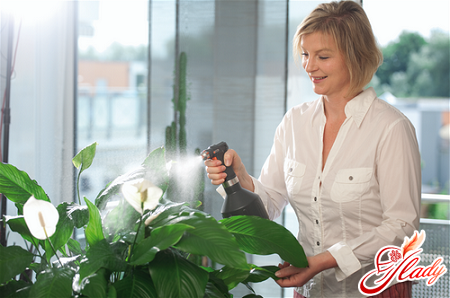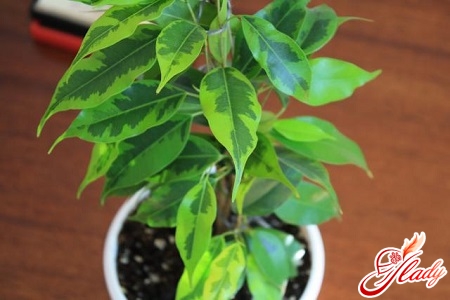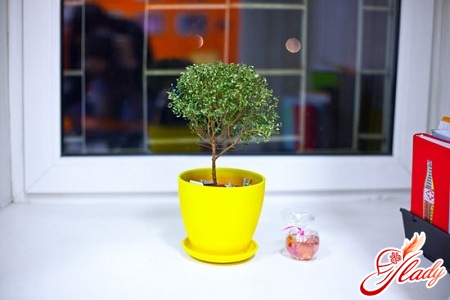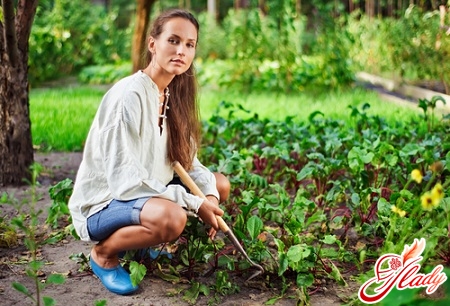
Cauliflower is an annual vegetablea plant of the cabbage family. Its homeland is the Mediterranean, and it is also widespread in Western and Northern Europe. Cauliflower was brought to Russia from Europe in the 18th century and is grown everywhere in small quantities. It is valued for its early maturity and taste, as well as for its uncomplicated care. The heads (modified inflorescences) of the plant are eaten, as they contain many vitamins and mineral salts. Cauliflower is very useful for gastrointestinal and cardiovascular diseases. The root system of cauliflower is located close to the soil surface and is less developed than the root system of white cabbage. After the formation of a rosette of 25-30 leaves, an inflorescence is formed, which has the appearance of a dense head of green, yellow, white or purple flowers. In general, cauliflower is more demanding to grow than other types of cabbage. It is sensitive to adverse conditions and care, although it is generally not demanding of heat, but it is less resistant to low temperatures than white cabbage. With their prolonged exposure, plant growth slows down, and the heads used for food are formed small. The optimum temperature for the formation of dense and large heads is 15-20 degrees. At temperatures above 25 degrees, small and loose heads are formed, especially with insufficient watering at this time. In addition to the ambient temperature, cauliflower is demanding of lighting conditions, especially during the period of growing seedlings. In conditions of long daylight hours, the formation of plant heads is accelerated, but subsequently they grow out and flowering shoots are formed. Artificial creation of conditions of shortened daylight hours leads to the formation of denser heads and prevents the formation of flower-bearing shoots. Of all cabbage, cauliflower is the most picky about the composition of the soil, its fertility. Its need for nutrients is twice as high as that of white cabbage. In addition to the main mineral and organic fertilizers used, it is in dire need of additional feeding with manganese, magnesium, boron and molybdenum. With a lack of microelements, weak development of heads, hollowness of the stalk, deformed leaves and usually rot of the heads are observed. Currently, about 10 varieties of cauliflower are zoned. Early maturing (vegetation period - 85-100 days) - Movir 74 (suitable for canning), Early Gribovskaya 1355, Snezhinka. Mid-early (vegetation period - 95-120 days) - Dotechestvennaya (suitable for canning), Moskovskaya Konservnaya and Garantiya. Late-ripening (vegetation period - 175-230 days) - Adler winter 679, Adler spring and Sochi.
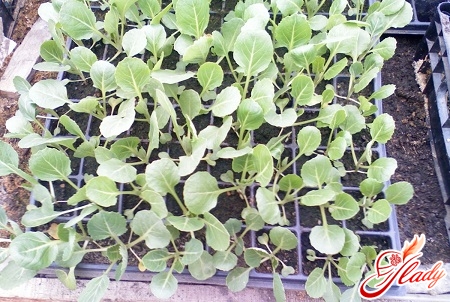
Cauliflowers: growing seedlings
Growing conditions and care of cauliflowerThe procedures for growing white cabbage seedlings are almost the same as for growing white cabbage seedlings. Seeds of early varieties are sown in seedling boxes installed in heated greenhouses or other heated rooms. About 2-3 g of seeds prepared for sowing are used for each seedling box. It is recommended to soak the seeds, for which they are placed in a gauze bag filled to 0.5 of its volume and soaked in clean water at room temperature for 10-12 hours. The soil is moistened before sowing and the seeds are sown to a depth of no more than 1 cm. After the seeds are embedded, the sowing is mulched with a thin layer of sand. About two weeks after the emergence of seedlings, the seedlings are picked. The seedlings of the earliest planting dates are grown in peat-humus pots. Seedlings of later dates can also be grown without pots. To do this, the seedlings are pricked out into the peat-humus soil of greenhouse beds or into seedling boxes. When 2-3 true leaves form, the plants are fed with a solution of potassium or ammonium nitrate, for which 5 g of ammonium nitrate and 15 g of potassium nitrate are diluted in a bucket of water. When 3-4 leaves form on the plants, foliar feeding is carried out by spraying with a solution of boric acid and ammonium molybdate (2 g per 10 liters of water). The seedlings are watered rarely, but abundantly, after watering the room is ventilated. About two weeks before planting in open ground, the seedlings are gradually hardened, accustoming the plants to the outside air temperature. The seedlings are ready for planting at the age of 45-50 days. By this time, the plants should have at least 4-5 leaves.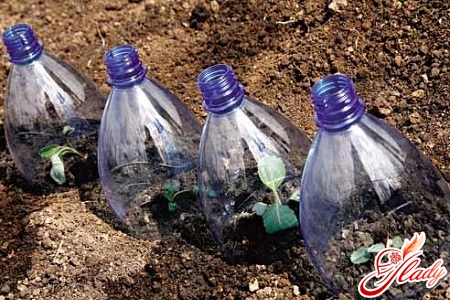
Cultivation of cauliflower in open ground
Regardless of the planting method, do not forget thatCauliflower is planted on the plot after such predecessors as legumes or root crops, onions, early potatoes or early varieties of cucumber. When grown as a repeat crop, cauliflower is placed after early green crops and winter sowings of root crops. For spring-summer cultivation of cauliflower, the soil is prepared in the fall. After harvesting the previous crop, it is carefully processed with a hoe to a depth of 6-10 cm. Then the plot is dug up, adding 7-8 kg of manure or peat-manure compost per 1 sq.m, provided that they were not added under the predecessors. In the spring, before planting, add mineral fertilizers to the soil (ammonium nitrate - 30 g, potassium chloride - 20 g and 50 g of superphosphate per 1 sq. m) and re-dig it, thoroughly loosening the clods. Early cauliflower seedlings are planted according to the scheme 70x25 cm, mid-season - 70x30 cm. Sometimes the row spacing is made narrower (50-60 cm), and the distances in the rows are wider (40-45 cm). When planting seedlings, add a pinch of ash to each hole, thoroughly mixing it with the soil. Then pour 1 liter of water into the hole and plant the plants. After planting, the seedlings are regularly watered until they adapt to the planting site. After a week, dead plants are replaced with new ones. Planting of seeds in open ground is carried out to a depth of 1 cm. Sowing, as a rule, is carried out with pre-soaked seeds. When the first true leaf appears, the plants are thinned out and 15-20 cm are left between them (with a row spacing of 70 cm) or 35-40 (with a row spacing of 50-60 cm). Further care for the sowing is the same as for seedlings. During cultivation, at least 5-6 waterings are carried out (at least 30 l / sq.m). A mandatory condition, especially during the formation of heads, is loosening the soil, which is carried out after each watering or rain. Care consists of cultivating the row spacing and hilling the plants. If necessary, fertilize with complete mineral fertilizer. In order to grow a full harvest, it is imperative to shade the cauliflower heads during the period of their intensive formation. In addition, the two upper leaves are tied above the head or broken off. This is done so that the head does not fall apart and retains its color.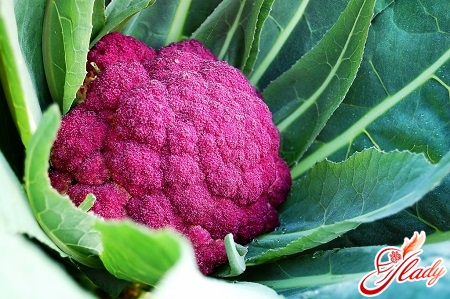
The secrets of harvesting
Proper care is not onlygrowing, but also competent harvesting. Cauliflower heads are harvested when they reach sufficient size. 2 or more kilograms of heads are harvested from 1 sq. m of planting. The heads are cut off together with 3-4 rosette leaves. Plants that have not had time to ripen before the end of the harvesting period are pulled out together with the roots and used for their further growing. For this, they must have heads with a diameter of about 5 cm and at least 20 leaves. For further growing, they are placed in heated greenhouses or hothouses cleared of biofuel, placing 35-40 plants per 1 sq. m. Then the plants are covered with shields, mats, black film and the temperature in the greenhouses is maintained at 5 degrees. As it gets colder, the hothouses are insulated with sawdust or other improvised means. Such a crop is harvested in December or January. Cauliflower heads can also be further grown in basements or cellars. In this case, the plants are tied and hung on trellises with the roots up. At the end of the growing process, the mass of the cauliflower heads reaches 0.5 kg, and the diameter is 15-20 cm. That's all the secrets - there is nothing complicated. Cauliflower heads are used as food fresh, boiled, fried. They are also marinated, used to prepare soups, casseroles, side dishes and salads.




